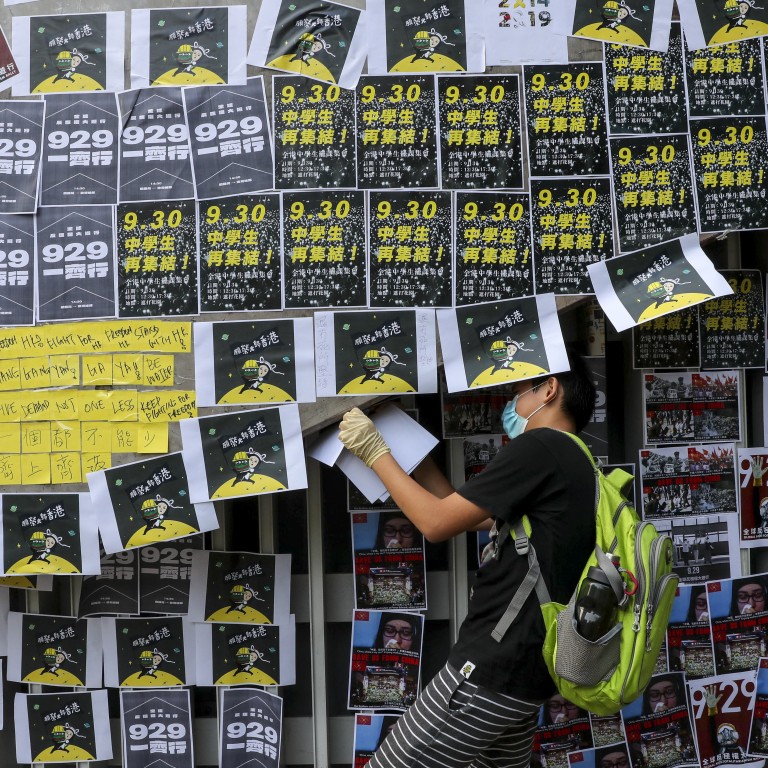
Hong Kong pro-democracy protesters declare ‘We are back’ in poster campaign from Victoria Park to Admiralty on fifth anniversary of Occupy movement
- Activists stick posters – on walls, escalators, footbridges and the pavement – all the way from to government headquarters
- Organisers estimates they prepared 10,000 posters, with the symbol of the Occupy movement – a yellow umbrella – showing up everywhere
Protesters on Saturday put up thousands of posters across downtown Hong Kong, many declaring “We are back” to the government on the fifth anniversary of the Occupy movement.
Some protesters formed human chains along sections of roads.
Posters pasted up in Causeway Bay recounted all the major protests since June 9, the date of the first major demonstration against the now-withdrawn extradition bill. Other posters listed the protesters’ demands to the government, while others promoted upcoming protests on Sunday and National Day on October 1.
Five years after Occupy, Hong Kong is riven by conflict and chaos
“We have freedom of speech,” Mike said. “We want to voice our opinions in a peaceful way.”
The symbol of the Occupy movement – a yellow umbrella – was seen everywhere, including on posters, T-shirts and a huge banner unfurled from a footbridge on Harcourt Road that read “We are back”.
The banner was a nod to a similar sign that declared “We will be back” at the same spot five years ago on the last day of the Umbrella movement. The police on Saturday took the banner down within an hour.
“To be honest, we failed,” he said. “We were fighting so hard for universal suffrage back then, and we still don’t have it now,” he said.
“But as we have seen throughout this summer, we Hongkongers will never give up. We said we would be back five years ago – and today here we are.”

A demonstrator in his 20s, surnamed Ho, was less optimistic.
“It’s not worth celebrating the anniversary, especially because we still need to come out and fight for freedom five years on,” he said.

But not all Hongkongers approved of the protesters and their tactics.
“This is not environmentally friendly,” said a 35 year-old woman surnamed Wan.
“Of course peaceful protests are better than violence, but there are other ways … like using social media. This is a waste of paper.”
Some shops closed early in Causeway Bay, including Starbucks on Fashion Walk and the Apple store at Hysan Place.
Ms. Pang, a housewife in her 40s, was waiting for a bus outside Southorn Playground in Wan Chai.
“I don’t support them, their violence has affected my life,” she said.
“They destroyed facilities at the MTR, which has a big impact on our daily life. Yes, they are putting up the posters peacefully now, but if you try to tear the posters off, there will be brawls.”
Donald Keung, a 15-year-old student, said he believed some of the violence was forced by the police.
“We got tear gas and rubber bullets for our peaceful demonstration. There is no inquiry into police violence yet, so I reckon our action might have been too conservative,” he said. “Compared to protests in other countries, our protests are less violent.”
Another protester, a 29-year-old surnamed Chin, said: “We still don’t have universal suffrage, and the police are getting worse. What we learned from the [‘umbrella movement’] is the Hong Kong identify, which is vital to us.
He continued: “Hong Kong is a very special city, a mix of Eastern and Western cultures, we should stick to that and keep this identity.”



